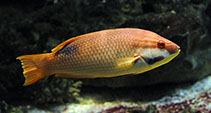| Family: |
Labridae (Wrasses), subfamily: Bodianinae |
| Max. size: |
55 cm TL (male/unsexed); max.weight: 1,812.0 g |
| Environment: |
reef-associated; marine; depth range 3 - 160 m |
| Distribution: |
Indo-West Pacific: east coast of Africa to Japan, the Philippines and New Caledonia. |
| Diagnosis: |
Dorsal spines (total): 12-12; Dorsal soft rays (total): 10-10; Anal spines: 3-3; Anal soft rays: 12-12. Young easily identified by the unusual coloration. Adults normally have an oval shaped black saddle near the tail, but it may become indistinct in large males (Ref. 48636). |
| Biology: |
Adults occur on deep reef slopes rich with invertebrates such as sponges and seawhips, but young adults are occasionally seen much shallower (Ref. 48636). Usually solitary in coral and rocky reefs. Feed mainly on benthic, hard-shelled, invertebrates such as mollusks and crustaceans. Protogynous (Ref. 55080). Oviparous, distinct pairing during breeding (Ref. 205). |
| IUCN Red List Status: |
Least Concern (LC); Date assessed: 12 March 2008 Ref. (130435)
|
| Threat to humans: |
harmless |
Source and more info: www.fishbase.org. For personal, classroom, and other internal use only. Not for publication.

